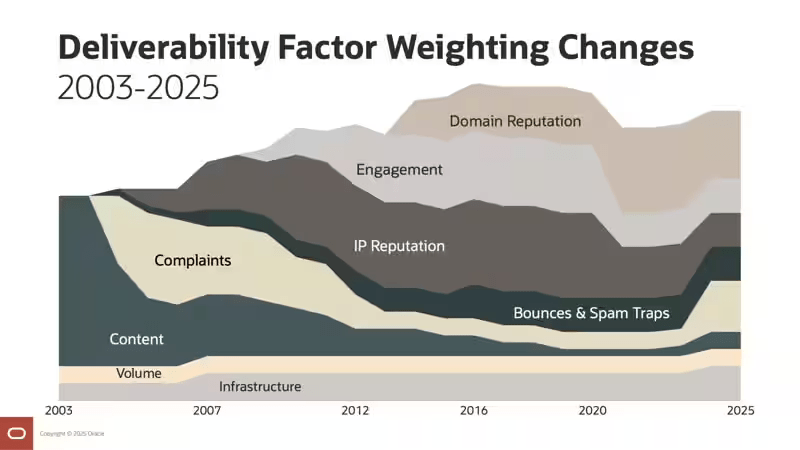At last, another source that validates what I explain all day long about the parameters that influence deliverability! Every time I explain the process of a deliverability auditThere comes a point when I explain that in an audit, I spend 70 % of my time analyzing the technical aspects... only to recommend actions that focus 70 % on engagement, data quality and interactions with your recipients.
I'm writing this article because Oracle, on the occasion of the a recently published webinar and articlehas produced a beautiful graph summarizing the evolution of factors influencing deliverability over the last 20 years. A graph that (fortunately) is largely in line with the deliverability tips of Badsender.
Let's dive into this analysis, which should make more than one email marketer think about their deliverability priorities.

Graph of deliverability factors between 2003 and 2025 - Source Oracle
What does this graph tell us about the evolution of deliverability?
Firstly, two parameters are relatively stable: volumes and infrastructure (with a slight change in recent years).
Secondly, and we can't stress this enough, content, which was totally central to deliverability in the early days, has shrunk incredibly (not for nothing did we write an article dedicated to theimpact on deliverability of the proportion of images in an email or theimpact of content on deliverability). This, too, needs to be repeated regularly.
Two parameters have become increasingly important in recent years: domain reputation and complaints.
As far as reputation is concerned, we can see (and we know) that there is a real gradual shift from IP reputation to domain reputation. This doesn't mean that IP reputation no longer carries any weight.
Finally, in the graph, commitment seems to be losing importance. This is a point of disagreement for me with the authors of the graph, but we'll come back to it a little later!
So which parameters have the greatest influence on deliverability?
If we transform the 2025 data into approximate percentages (made with a ruler by measuring the height on my screen, not a very scientific method inside 😉 ), here's what it looks like:
- Domain reputation : 23 %
- Complaints : 19 %
- Infrastructure : 12 %
- IP reputation : 12 %
- Bounces and Spam Traps: 12 %
- Commitment: 12 %
- Volume : 5 %
- Contents: 5 %
Finally, apart from domain reputation and complaints, which are higher than the other parameters, and volume and content, which are lower, there is no one indicator that crushes all.
If we put together what I called in my introduction "engagement, data quality and interaction with your recipients".we get 55 % of the total. And if we consider that in IP/Domain reputation, there are many parameters influenced by "engagement, data quality and interactions with your recipients", we easily get our 70 %.
For the technical parameters deliverabilityIn the infrastructure section, which is partly concerned with volume and content, but also again with IP/domain reputation, we get just under 30 %.
So I can say that overall, I'm pretty much in agreement with these ratios.
Deliverability factors vary from country to country and from sector to sector!
OK. So these parameters can be taken as absolute truths? Mhmmm, not really! As a reminder, the parameters and factors influencing deliverability vary for each e-mail operator.
That's why it's vital to know the composition of your database, and especially the distribution of your recipients by email address domain (or destination).
Here are a few elements that can strongly influence the weighting of these deliverability parameters:
- The countries to which you send your e-mails Is there a strong presence of the big international webmails, or do the majority of recipients use local messaging services?
- The demographics of your recipients : Depending on generation, gender, social background, etc., there are major disparities in the email box providers used. For example, in B2B in France, Gmail is often number one, except for databases of older people who will have Orange as number one.
- B2B or B2C : Obviously, if you're targeting B2C recipients, you'll mainly be sending your messages to mass-market mailboxes... and in B2B, to a multitude of professional domains (which will be managed by a few large, specialized solutions).
There are undoubtedly others 😉
Is this diagram perfect? Can I take it literally?
Generalizing is a tricky business. Deliverability is not an exact science, but the sum of experiments, collected clues and incomplete information gathered by industry experts. Summarizing deliverability parameters in such a small graph is therefore a feat, but can also be (gently) criticized.
My biggest criticism concerns the little room for commitment in the graph. From a pedagogical point of view, it seems essential to say over and over again that improving engagement is central to a good deliverability strategy.
Nevertheless, I understand the authors' difficulty in also leaving room for IP and domain reputation, which is strongly influenced by... engagement. So let's say that in the 35 % of reputation in the graph, we also find engagement.
Another remark: if spam complaints have come back to the fore in recent years (thank you Gmail and Yahoo!), it's a bit risky to think they'd lost so much weight. This is especially true in Europe, where engagement metrics are less easily exploited than in the US.
Concerning infrastructureI totally agree with the chart. Its importance is evolving, but it is far from being a determining factor in a deliverability improvement strategy. Not correctly configure your email authentication will make emailing impossible, but having a well-configured infrastructure will never guarantee delivery of your emails.
Nonetheless, this graph is a great opportunity to think about your deliverability and the levers you have at your disposal to improve it.
Leave a Reply